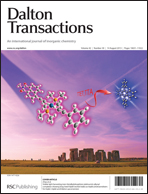Symmetrical and unsymmetrical dithiocarbamato pyridine solvated and non-solvated complexes of indium(III) with the general formula [In(S2CNRR′)3]·n(py) [where py = pyridine; R,R′ = Cy, n = 2 (1); R,R′ = iPr, n = 1.5 (2); NRR′ = Pip, n = 0.5 (3) and R = Bz, R′ = Me, n = 0 (4)] have been synthesized. The compositions, structures and properties of these complexes have been studied by means of microanalysis, IR and 1H-NMR spectroscopy, X-ray single crystal and thermogravimetric (TG/DTG) analyses. The applicability of these complexes as single source precursors (SSPs) for the deposition of β-In2S3 thin films on fluorine-doped SnO2 (FTO) coated conducting glass substrates by aerosol-assisted chemical vapour deposition (AACVD) at temperatures of 300, 350 and 400 °C is studied. All films have been characterized by powder X-ray diffraction (PXRD) and energy dispersive X-ray analysis (EDX) for the detection of phase and stoichiometry of the deposit. Scanning electron microscopy (SEM) studies reveal that precursors (1)–(4), irrespective of different metal ligand design, generate comparable morphologies of β-In2S3 thin films at different temperatures. Direct band gap energies of 2.2 eV have been estimated from the UV-vis spectroscopy for the β-In2S3 films fabricated from precursors (1) and (4). The photoelectrochemical (PEC) properties of β-In2S3 were confirmed by recording the current–voltage plots under light and dark conditions. The plots showed anodic photocurrent densities of 1.25 and 0.65 mA cm−2 at 0.23 V vs. Ag/AgCl for the β-In2S3 films made at 400 and 350 °C from the precursors (1) and (4), respectively. The photoelectrochemical performance indicates that the newly synthesised precursors are highly useful in fabricating β-In2S3 electrodes for solar energy harvesting and optoelectronic application.

You have access to this article
 Please wait while we load your content...
Something went wrong. Try again?
Please wait while we load your content...
Something went wrong. Try again?


 Please wait while we load your content...
Please wait while we load your content...